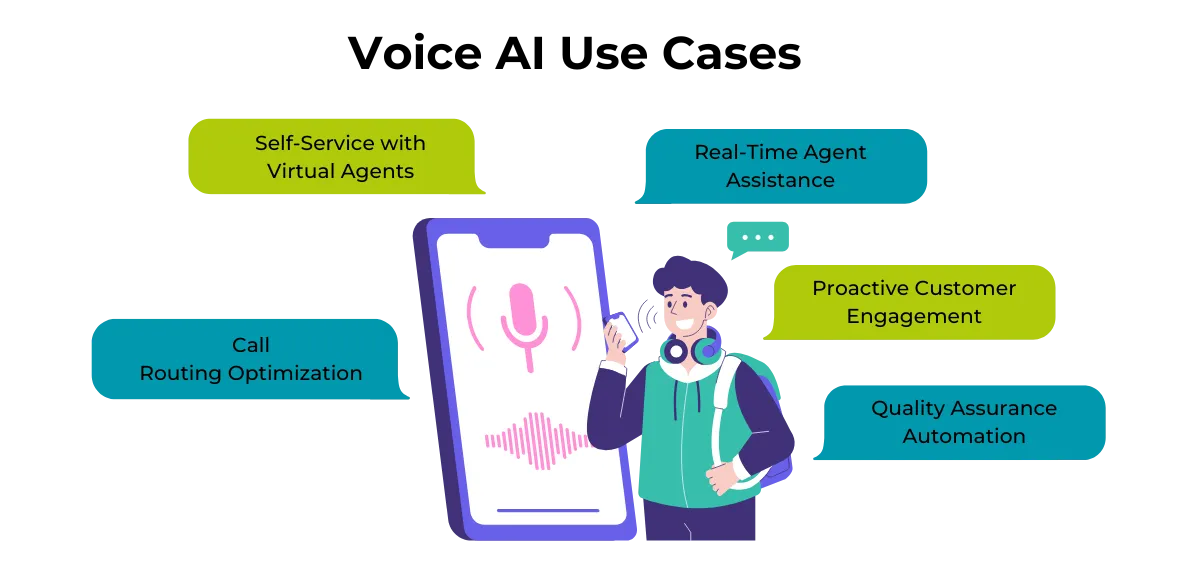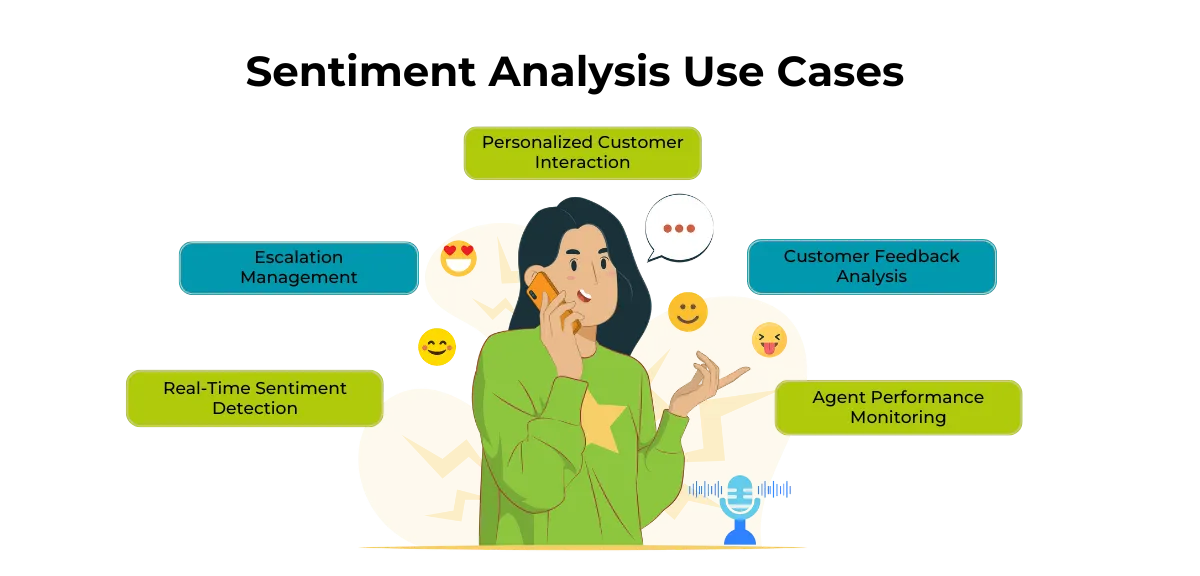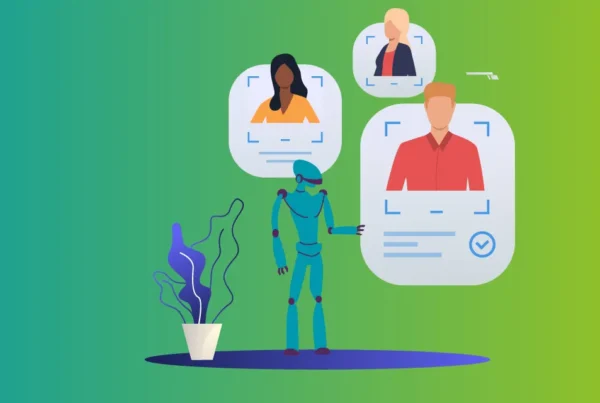
First, let’s get down to the basics.
What is Voice AI?
Voice AI is the tech magic behind talking to our devices like they’re people. Think of it as the “brains” that allow Siri, Alexa, and Google Assistant to actually understand what we’re saying and respond in real time. It’s powered by advanced algorithms and machine learning, which enable it to recognize our voices, interpret our words, and figure out the best way to respond—whether we’re asking for a weather update, a new playlist, or a reminder to water the plants.
Basically, Voice AI is what turns our gadgets into conversational buddies, ready to help out, answer questions, or even tell a joke. And it’s not just about having fun; Voice AI is also getting pretty good at picking up on our moods and tones, making it even more responsive. So, every time we chat with our devices, we’re actually engaging with a pretty advanced, voice-powered assistant that’s designed to make life a little easier (and sometimes a little more entertaining).
Now, what is Sentiment Analysis?
Sentiment analysis is like teaching computers to understand feelings. It’s a type of AI that listens to what we say—or reads what we type—and tries to figure out if we’re happy, frustrated, annoyed, or even just neutral. Think of it as emotional intelligence for machines.
Here’s how it works: sentiment analysis looks at the words we use, the tone of our voice, or even the way we structure sentences. For example, if you say, “I can’t believe how easy this is!” in a cheerful tone, the system picks up on your excitement. But if you say, “I can’t believe this,” with a sigh, it might recognize frustration.
This technology is used everywhere—from customer service calls to social media monitoring. It helps businesses understand how people feel about their products or services, and it gives them a chance to respond in a way that’s more thoughtful and human-like. It’s like giving machines a bit of empathy (but without the tears).
Let’s discuss this in the context of Contact Centers.
Contact centers are at the heart of customer service, and with tech like Voice AI and sentiment analysis, they’re leveling up in a big way. These tools are changing the game, making every customer interaction faster, more personal, and even a little more human.
How Contact Centers are evolving with the introduction of Voice AI and Sentiment Analysis
Voice AI takes care of repetitive tasks, helping agents focus on what really matters—solving customer problems. Here’s what makes it so powerful:
- Live Transcription for Quick Action: Voice AI listens and types at lightning speed, transcribing conversations as they happen. Agents get instant insights, making it easier to respond quickly and with just the right info.
- Your New Go-To Helper: Virtual agents (fancy talk for chatbots with superpowers) can handle everyday questions like “What’s my balance?” or “How do I reset my password?” Meanwhile, the human agents can tackle the trickier stuff.
- Always-On Service: Whether it’s 2 PM or 2 AM, Voice AI doesn’t sleep. It’s there to help customers any time they call, no matter where they are.
And the best part?
Voice AI gets smarter with every call, picking up on different accents, slang, and ways people phrase things. So, the more it works, the better it gets.
Adding empathy with Sentiment Analysis
Now let’s talk about feelings. Sentiment analysis gives contact centers a sixth sense, helping them understand not just what customers are saying, but how they’re saying it. It’s like emotional intelligence for machines. Here’s how it works:
- Picking Up on Moods: It listens for clues in tone, pitch, and word choice to figure out if someone’s excited, annoyed, or somewhere in between.
- Knowing When to Step In: If frustration starts bubbling up in a customer’s voice, the system sends up a flare so an agent (or even a supervisor) can jump in before things go south.
- Personalized Responses: Once the system gets a read on a customer’s mood, it helps agents match their tone—whether that’s being upbeat and cheerful or calm and understanding.
Picture this: a customer calls about a delayed order. They’re clearly frustrated. Sentiment analysis picks up on the tone and suggests the agent acknowledge their frustration and offer a quick resolution.
Result? A happier customer who feels heard and valued.
Why Voice AI and Sentiment Analysis matter for Contact Centers
Today, customer expectations for fast, personalized service have skyrocketed, pushing companies to adopt sophisticated AI-driven solutions to meet demand. Research shows that 60% of customer service agents find AI beneficial for time management, allowing them to handle more calls and focus on complex queries (Dialpad, 2024).
The industry-wide integration of advanced Voice AI tools, such as generative AI, is enabling contact centers to enhance customer experience significantly, positioning them to adapt quickly to changing expectations and needs (Zendesk, 2024).
By teaming up Voice AI and sentiment analysis, contact centers can deliver experiences that leave customers smiling (or at least a lot less annoyed). Here’s what’s in it for them:
- Happier Customers: Personalized, empathetic support makes a world of difference in how customers feel about a brand.
- Smoother Operations: When routine tasks are automated and urgent calls are flagged, things run like a well-oiled machine.
- Less Stress for Agents: Real-time insights and suggestions mean agents spend less time scrambling and more time solving.
- Smarter Decisions: Every call adds to a treasure trove of data, helping businesses learn what their customers love—and what needs fixing.
Use Cases
Voice AI and sentiment analysis go beyond traditional call handling, enabling real-time transcription, emotional insight, and tailored responses that create a seamless experience for both customers and agents. They aren’t just buzzwords; they’re practical tools transforming how contact centers operate. Here are some compelling use cases that highlight their impact in contact centers.
Voice AI

Call Routing Optimization
Voice AI analyzes the caller’s initial query and routes the call to the most appropriate department or agent.
- Benefit: Reduces wait times and ensures customers speak with someone who can resolve their issue right away.
Self-Service with Virtual Agents
Virtual agents handle routine inquiries, such as checking account balances, updating contact information, or resetting passwords.
- Benefit: Frees up human agents for more complex issues while providing 24/7 support.
Real-Time Agent Assistance
During a call, Voice AI provides live transcriptions, suggests relevant responses, or displays key customer details.
- Benefit: Agents can focus on the conversation without hunting for information, making calls smoother and more efficient.
Proactive Customer Engagement
AI can detect trends in customer calls and proactively reach out with solutions, such as notifying customers about service outages or promotions.
- Benefit: Enhances customer satisfaction by solving issues before they escalate.
Quality Assurance Automation
Voice AI reviews recorded calls for adherence to scripts, compliance, and customer satisfaction indicators.
Benefit: Streamlines quality assurance processes and identifies training opportunities for agents.
Sentiment Analysis

Real-Time Sentiment Detection
Sentiment analysis monitors tone, word choice, and vocal pitch during calls to identify customer emotions.
- Benefit: Agents can adjust their approach in real time, ensuring empathy and de-escalating frustration.
Escalation Management
If a customer’s frustration reaches a critical point, the system flags the call for escalation to a senior agent or supervisor.
- Benefit: Helps prevent negative experiences from spiraling into dissatisfaction or churn.
Personalized Customer Interaction
By understanding customer sentiment, agents can adapt their tone and language to match the caller’s mood.
- Benefit: Creates a more human and empathetic interaction, increasing customer loyalty.
Customer Feedback Analysis
Sentiment analysis reviews post-call surveys and feedback forms to identify trends in customer satisfaction.
- Benefit: Businesses can address recurring pain points and enhance overall service quality.
Agent Performance Monitoring
Sentiment trends in calls handled by specific agents can reveal who excels at managing difficult situations and who may need additional training.
Benefit: Improves team performance and ensures consistent service quality.
The Future is Here: Redefining Customer Service
Voice AI and sentiment analysis aren’t just futuristic concepts.These technologies are revolutionizing how businesses interact with customers, blending cutting-edge innovation with a much-needed human touch.
The result?
Customer service that’s not only faster but also smarter, more empathetic, and deeply personalized.
Imagine a contact center where calls are routed seamlessly to the right agents, routine queries are resolved instantly by virtual assistants, and agents receive real-time support to tackle even the trickiest problems. Voice AI makes this possible by automating repetitive tasks, providing instant insights, and learning from every interaction to get better over time.
Sentiment analysis brings emotional intelligence to the table, picking up on whether a customer is happy, frustrated, or upset. This gives agents the power to respond with empathy and precision, turning tough situations into positive experiences.
When combined with Voice AI, these tools are transforming customer service. Voice AI cuts down wait times and offers around-the-clock support, while sentiment analysis keeps a finger on the emotional pulse, catching dissatisfaction before it spirals. Together, they’re more than just problem-solvers—they create standout experiences that make customers feel genuinely heard and valued.
The impact is transformative:
- For Customers: Faster resolutions, empathetic responses, and a more seamless experience.
- For Agents: Reduced stress, better tools for handling calls, and the ability to focus on meaningful conversations.
- For Businesses: Increased efficiency, cost savings, and actionable insights to improve services continuously.
Voice AI and Sentiment Analysis are changing the game, and it’s only getting better. Contact Centers can predict what customers need before they even ask, handle escalations more smoothly, and deliver truly personalized interactions. Whether you’re running a business and want to stand out or you’re a customer tired of feeling like “just another caller,” the future looks pretty exciting. These advancements mean more meaningful connections and better experiences for everyone.
With these technologies leading the way, we’re moving toward a world where every customer interaction feels not just effective but also truly human.



